► The difference between self driving and autopilot
► Tesla’s lineup
► What Elon has in store for the future
Tesla’s 2023 Investor Day was a wide-reaching affair, covering everything from humanoid robots to the brand’s next-generation EV platform. However, alongside all the above – and CEO Elon Musk’s plan to create a sustainable global economy – we also got to hear more about the brand’s autonomous, self-driving software.
Everything in the presentation hinged on Musk’s vision to create a totally sustainable, electrified society, but it turns out Tesla’s self-driving tech plays a key part in it: ‘Currently, when a car is not being used, it is sitting idly in parking lots not doing anything,’ said Ashok Elluswamy, Tesla’s director of self-driving. ‘But if autonomy is truly unlocked this car, instead of being idle, can go serve other customers. This fundamentally reduces the need for scale manufacturing to extreme levels, because each car is being used way more.’
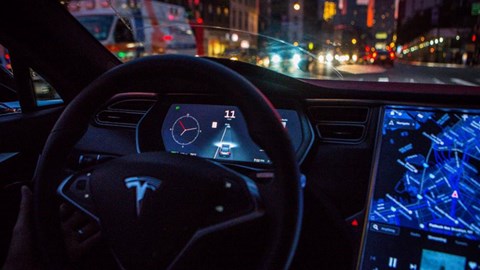
In addition to explain how Tesla’s autonomous could help the world, the brand also explained just how it’s constantly improved.
Using AI to train AI
The most efficient machine learning can only be achieved with the best, relevant data, and Tesla uses an automated process to mine and then sort through and label anonymous data from its cars. After that, Tesla engineers only feed their self-driving AI the most relevant examples for the problem at hand, thus enabling quicker, more accurate learning. In this way, Tesla is using automation to teach AI.
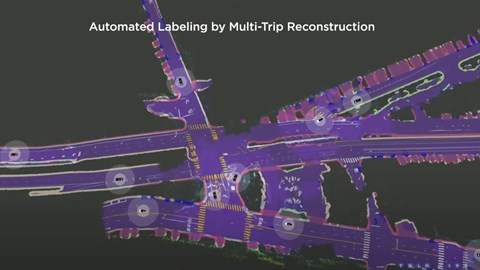
‘Back in the day for example, we had some false braking where we thought this car that’s actually parked there was going to move into our path, and hence we were [preemptively] braking, but it was unnecessary to brake because the car was truly parked’ explained Elluswamy.
‘We mined the fleet for similar cases where the car was braking due to some parked cars, then added 14,000 videos to our training set, and then once we trained the network’s again with this new data. It now currently understands that okay, there is no driver in this car, and it must be parked, then there is no need to break.’
Tesla calls this systematic approach its data engine, and it’s a cyclical, constantly evolving thing: ‘Once you have the newly trained models deployed onto the fleet, we rinse and repeat this process, everything gets better and better,’ Elluswamy added.
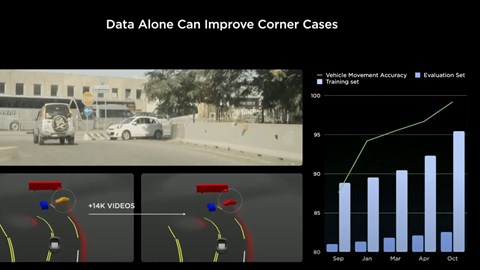
Keep reading to find out more about Tesla’s self-driving tech, what models are currently around, what it has in store for the future, as well as find out why we find the Autopilot system a bit disappointing.
Tesla self-driving in reality
Read any review of a Tesla (including our own) and two big reasons for buying or leasing one will rear their heads. The Supercharger charging network (which has recently opened up to other brands) and Tesla’s self-driving tech.
Despite Tesla’s advanced systems, Musk mused that self-driving cars needn’t be overly complex. While speaking at a Financial Times conference, Musk said: ‘I don’t think you need full human-level intelligence to drive a car. You need sufficient human-level intelligence to drive a car, but you don’t need deep conceptual understanding of esoteric concepts or anything like that. You need sufficient intelligence to match what human neural nets do when driving a car.’
Full self-driving Tesla?
If, like many, you choose to spec a Tesla on the company’s website, you’ll see an options list. For just shy of £7,000 (at time of writing) you can add ‘Full Self-Driving Capability’. This includes things like auto lane change, auto park and summon, and it’ll stop at traffic lights and stop signs too.
Tesla states that a ‘future update’ will allow its cars to autosteer on city streets. But at the moment legislation in the UK won’t allow for this. A Tesla spokesperson told us CAR that the company has no estimated release date for it. So a full self-driving Tesla is still a fair way off.
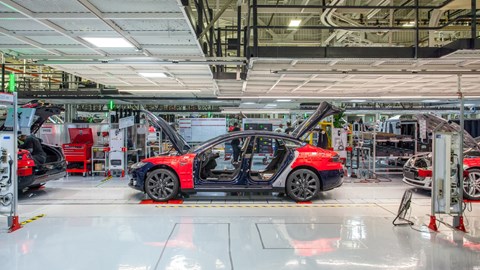
Regulators authorising level three autonomy keep putting it further and further back (it was originally slated for 2021) and even then, that’s still not fully self-driving.
Semantically, Tesla’s ‘Self-Driving Capability’ is redundant as it simply doesn’t offer fully autonomous vehicles. Look at Tesla’s website and it’ll even tell you these features ‘do not make the vehicle autonomous.’
Musk said: “We have never said, ever, that Tesla Autopilot does not require attention. We have always made that extremely clear, repeatedly, you can’t even turn it on without acknowledging that it requires supervision.”
What level of autonomy is Tesla’s self-driving system?
There are five levels of autonomous vehicles. Level 0 is basically no automation whatsoever, not even cruise control. Level 1 features a system that can assist with steering or braking, but not simultaneously.
Level 2 has partial automation, but the human must pay full attention and have their hands on the steering wheel. With level 3, the vehicle can perform all aspects of driving under some circumstances but the human must be ready to take over. Level four is very sophisticated and the vehicle can perform more driving in more circumstances. Level five is full automation. The human is just a passenger.
Crucially, only levels one and two are permitted by UK Law. So Tesla’s Autopilot only has level two automation.
Level two offers partial automation. Both steering and braking/acceleration can be controlled by the car, but the human driver must continue to pay full attention at all times and perform the rest of the driving task.
Tesla self driving cars: What’s available now?
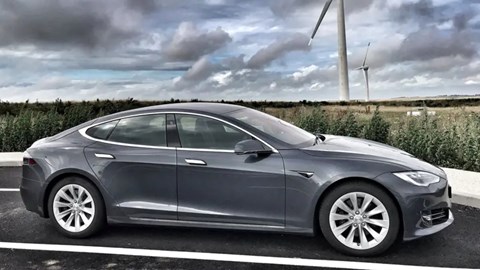
Tesla’s oldest and most traditional model. The S is a five-door saloon, made to look like a four-door, that’s currently only available in two trims. The regular model has a WLTP-backed 405-mile range while the Plaid has a 0-60mph time (well not quite 0, as Tesla lets their cars get a running start…) of under two seconds thanks to tri motors and 1006bhp.
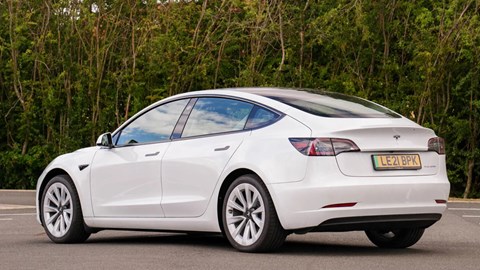
This is Tesla’s smallest and cheapest model. Confusingly it looks like a hatchback, but it’s actually a saloon. It’s available in three models: the regular one sports a 305-mile range, the Long Range ups things to 374 miles and the Performance has a 0-60mph time of just a smidge over three seconds.
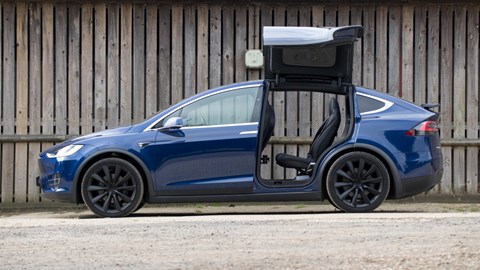
Tesla’s largest model. If you’ve been on Instagram or Tik Tok lately you’ll have seen that it has ‘Falcon’ doors (that open up and out, like a Falcon’s wings). But it’s also a genuinely useful family SUV with a range of up to 348 miles. Can also come in Plaid spec complete with more than 1000bhp.
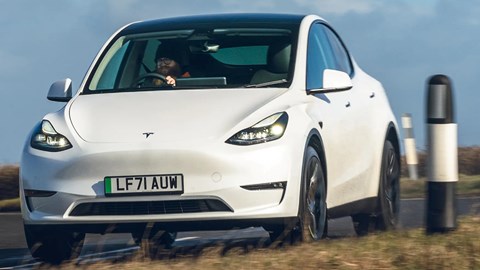
The company’s newest car. Think of it as a halfway house between a Model 3 and a Model Y and you’re about there. It’s selling by the bucketload in the UK thanks to keen leasing deals.
CAR’s Tesla Autopilot verdict
We’ve driven Tesla’s Autopilot system in America, mainland Europe and the UK. It works OK, as long as you remember this is absolutely not in any shape a full self-driving system.
If you expel any notion of ‘hands off’ driving, Tesla’s Autopilot works much in the same way as any other level 2 semi-autonomous system.

You can see that with each software update, the system becomes more intuitive, less nervy, and more capable of dealing with busy situations.
On America’s large and expansive highways it mostly leaves you alone, but in the UK it’s twitchy and jerky while keeping you in lane. It can also be spooked by the UK’s poorly maintained roads. After all, it’s constantly ‘looking’ for those white lines that often disappear.
The same can be said for many other car makers’ semi-autonomous tech, but we find Mercedes’ to be much better suited to UK roads.
What’s next?
Like with other carmakers, Tesla’s hamstrung by the UK’s perceived lack of legislation movement. The next big thing (assuming these changes come in) is Tesla’s Autosteer in city streets. This allows the Tesla to change lanes if the person behind the wheel indicates.
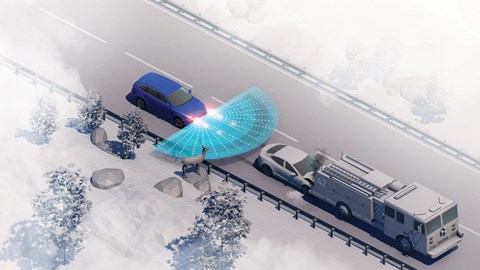
One of the major criticisms about Tesla’s efforts for full self-driving is its lack of Lidar. For years Musk had thought Lidar (a type of sensor used to create 3D maps) a waste of time, but last year a Model Y was spotted testing with Lidar equipment in Florida.
What does Musk reckon? Well, he said: “Self-driving is one of those things where there are a lot of false dawns. You think you’re getting there but it tapers off. I think we are actually quite close to achieving self-driving at a safety level that is better than human.
“My best guess is that we’ll get that this year (2022). We’re really not far from it. The progress is dramatic. I think ultimately probably a factor of 10 safer than a human, as measured by the probability of injury.”